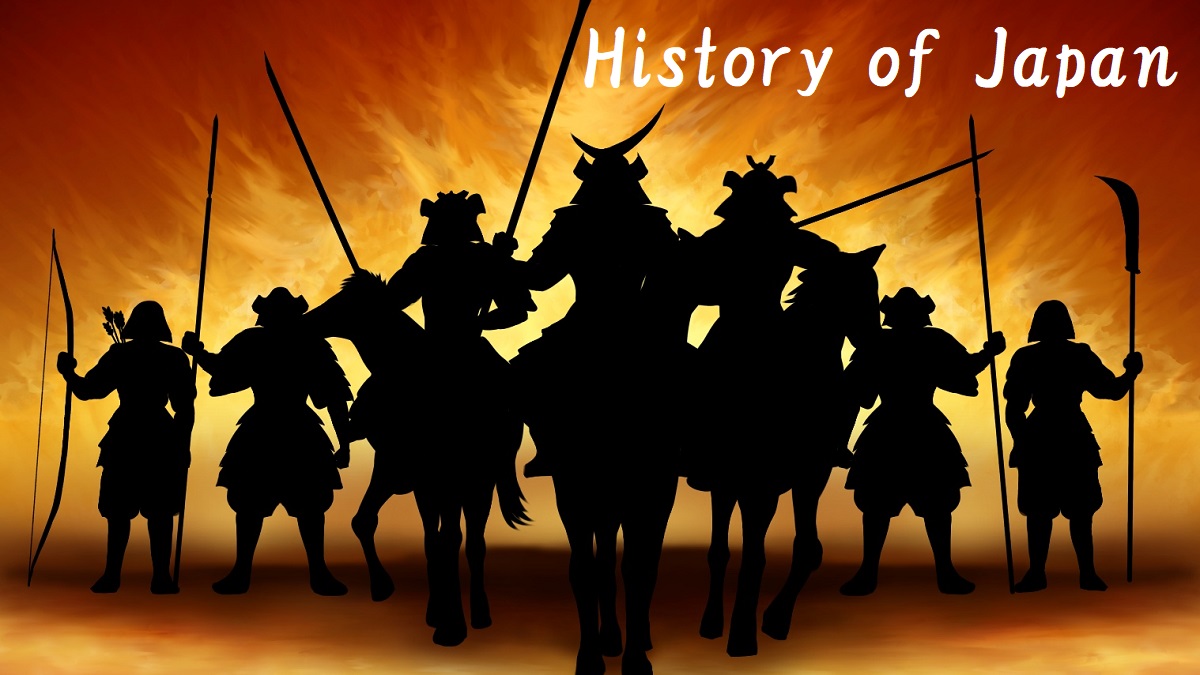Short history of Japan
Prehistoric Japan
Originally, the islands of Japan were a part of Asian Continent.
And, the Sea of Japan was a large lake.
About 12,000 years ago, erosion by the sea separated the islands of Japan from the continent.
From this era, ancestors of Japanese began to live in these islands.
No single theory has been accepted, but it is said that they came from the three directions.
They are from Northeast China through Korean peninsula, from South China through current Okinawa islands, and from Far East Russia through Sakhalin island.
Jomon Period
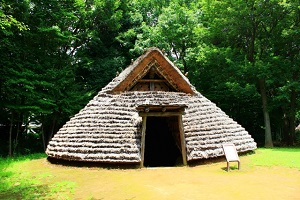
Pit house in Jomon Period
Until the 3rd century B.C., people lived on hunting, fishing, and gathering of nuts and fruits.
And they made and used earthenware.
This period is called as "Jomon period".
Yayoi Period
After that, until 3th century A.D., farming became the basis of the lives of people.
So, many people lived in an area, then many primitive countries were formed.
This period is called as "Yayoi period".
Small kingdoms appeared
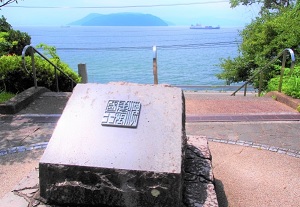
Monument of golden seal in the park where the seal was found
In an old history book in China, it is written that a King of China presented a golden seal to the envoys from Japan in 57 A.D.
And, the seal was excavated from the field in Fukuoka city in the 18th century, by chance.
Also, it is written that Queen Himiko governed a country and she dispatched an envoy to Wei (a part of current China) in 239 A.D.
Her country was called "Yamataikoku", and it is thought that the country (a kingdom) was the most powerful in Japan.
But, many scholars are still continuing to study and argue where the capital of Yamataikoku was.
And it is thought that Kanji (Chinese characters) were introduced from China in this period.
Kofun Period
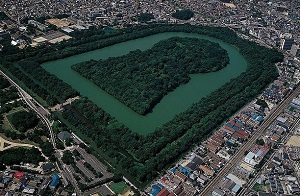
@JNTO, World's largest tomb, Kofun of the Emperor Nintoku
From the 3rd to 7th centuries, some countries in west Japan formed a group.
And some kings began to govern.
About the Emperor in Japan ("Ten-no") today, these kings seem to be an origin.
"Kofun" is a burial mounds.
The kings in this era built them as the symbol of power.
More than 150 thousand Kofuns remain in whole Japan.
Especially, very large Kofuns remain around Osaka city.
They are the tombs of the Emperors in the period.
Asuka Period
In the 6th century, Buddhism was introduced from China through Korean peninsula.
In the early 7th century, Prince Shotoku pushed for the construction of a nation based on Buddhism.
And he built Horyuji temple.
He opened the capital at Asuka area (south of Nara city), and governed by following political system and culture of China.
In this period, the political system centering on the Emperor established.
Nara Period (710 - 794)
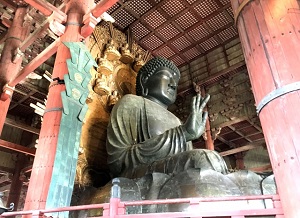
Great Buddha seated statue in Todaiji temple
In 710, the capital was moved to Nara city, and the full-scale nation started.
The Emperor governed the nation, managed farm land, exacted taxes, and created the army.
For Buddhism, Todaiji temple was built and Daibutsu (Great Buddha seated statue) was created.
In this period, the oldest history books "Kojiki", "Nihon-shoki", and a collection book of Japanese poetry "Man-yoshu" were published.
Heian Period (794 - 1185)
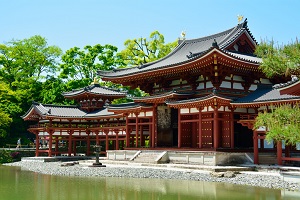
Byodo-in Houodo temple in Uji city, built in 1052
In 794, the capital was moved from Nara to Kyoto.
The city of Kyoto was modeled on the Xian city in China.
During this long period, the government shifted power from the center to the regions.
But the governing area was still only in west Japan.
And the ministeries began to do the politics for the Emperor.
Fujiwara family was the strongest in the situation.
Fujiwara had marital relations with Emperor family, and kept the political post.
Toward the end of this period, "Bushi" (Samurai / the employed soldier) was getting powerful, and Taira family assumed the reins of government.
Fujiwara family was already declining.
In this period, Kana characters (A phonogram of Japanese language) made from Kanji (Chinese characters).
So, "The Tale of Genji" was written in Kana and Kanji characters. It is the oldest long romance novel by a female novelist in Japan.
Kamakura Period (1185 - 1333)
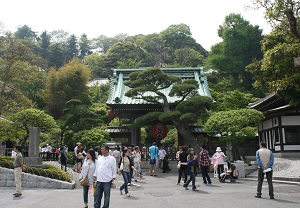
Hasedera temple in Kamakura city
At the end of Heian Period, Minamoto family of Bushi destroyed Taira family.
They opened the new government at Kamakura city (about 50km south of Tokyo).
So, two governments existed in this time. (Kamakura and Kyoto where the Emperor lives)
They held real power under Bushi's initiative, so the economy developed.
But, the greatest danger in Japanese history occured.
It was Mongol invasions in 1274 and 1281.
Mongol occupied the whole China, Korea and central Asia in this period.
And to occupy Japan, they tried to invade twice.
Japan army fought desperate defensive battles around the north coast of Kyushu Island, and prevented the invasion to the inland of Japan.
Fortunately, in the 2nd invasion, a typhoon passed this area and the fleet of Mongol suffered heavy damages on the sea.
So, Japan was saved.
But, after that, the nation had been reduced to poverty economically by the war.
And Kamakura government had declined.
On the other hand, Western people knew about Japan at the first time in this period.
Marco Polo, a Venetian merchant traveller, introduced Japan as a golden country in his "Book of the Marvels of the World" in the late 13th century. (He stayed in China, but didn't visit Japan.)
Muromachi Period (1336 - 1573)
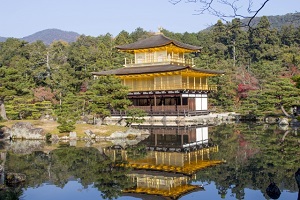
Kinkakuji temple in Kyoto, built in 1397
At the middle of 13th century, Emperor family was divided by Imperial succession.
All Bushis were caught up in the confusion by the trouble and Mongol invasions, then the government of Kamakura was destroyed.
A strong Bushi Ashikaga Takauji took side of the Emperor family, and destroyed the other family.
So, the Emperor assigned him to "Shogun" (means the head of the government in feudal age).
He opened a new government at Muromachi town in Kyoto.
Kinkakuji which is a golden temple in Kyoto was built by Ashikaga Yoshimitsu (a grandchild of Takauji) in 1397.
But after they died, impractical Shoguns continued, so chaos spread across the country.
Until the middle of the early 16th century, a power struggle continued and the country was in a domestic conflict.
Especially from the late 15th century, it is called as "Sengoku Period". In English, it is translated as "Age of Warring States".
In this period, many powerful local lords acted to expand their own territory under the confusion of central government.
Therefore, the battles often occured in different places in Japan.
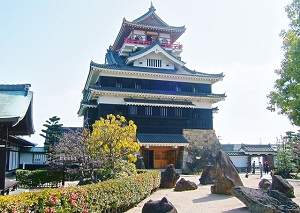
Simulated Kiyosu Castle where Oda Nobunaga was born
Among them, Oda Nobunaga (born near current Nagoya city) unified the current Tokai area.
He went to Kyoto soon in 1568, and the government was forced to accept that he was the top of local lords.
But many lords reacted against Oda and the government, then the Shogun lost his position and Muromachi government ended in 1573.
And Oda was assassinated in 1582.
During this period of wars, the culture from Europe came to Japan.
In 1543, a ship of China drifted to Tanegashima Island to the south of Kyushu.
Portugueses were on the ship, and they introduced guns.
Probably, it was the first time that Japanese people met European people.
And in 1549, Francis Xavier (Roman Catholic missionary) came to Kyushu and introduced the Christian religion.
Azuchi-Momoyama Period (1568 - 1600)
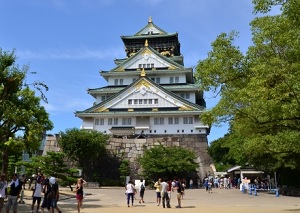
Osaka Castle built by Toyotomi Hideyoshi
After Oda was killed, his top-class retainer Toyotomi Hideyoshi was distributed main part of territory of Oda.
He was originally a poor farmer, but became a successful man like Napoleon Bonaparte.
He was full of wisdom, so Oda put a high value on the ability of Toyotomi.
He gained over many friend, and won some battles against his rivals.
At last, he united all country of Japan in 1591.
His ambition was too big.
Because, he tried to advance his troops to China in 1592 and 1597.
But, Toyotomi died in 1598, and the plan of war to China was stopped.
Naturally enough, the west Japan was exhausted by the reckless and wasteful war.
By death of Toyotomi, a brilliant tactician Tokugawa Ieyasu governed a territory to the east of current Nagoya got a chance to become the leader.
He challenged Toyotomi side to a battle.
He had already enlarged the number of friends.
In 1600, Tokugawa troops and former Toyotomi troops stood face to face in the middle of Japan.
About 180 thousand soldiers fought the battle there, but Tokugawa won easily within a day.
Because, many soldiers betrayed Toyotomi troops and joined Tokugawa troop by advance plot.
This battle is called "Battle of Sekigahara", and is well-known in Japanese people.
He was assigned to new "Shogun", and he opened a new government at Edo (Tokyo today).
This was the end of long war period.
By the way, "Azuchi" is the name of the castle where Oda lived, and "Momoyama" is the name of the castle where Toyotomi lived.
Edo Period (1603 - 1867)
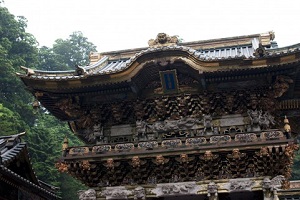
Yomeimon Gate in Nikko Toshogu enshrining Tokugawa Ieyasu
During this long period, Tokugawa family governed Japan for 15 generations.
The government closed the country for national stability.
But, they admitted trade only with China and Dutch East India Company.
Christian religion had come from Europe in 1549, but the government forbad the Christian faith in 1614.
The system of governing was feudal, but civil society was relatively free.
And Edo became the largest city in the world. (The population was over a million.)
The economy and culture developed though some economic standstills and some famines occured.
Especially, the citizens created the various culture.
Most of them are the Japanese cultures which many foreign tourists are interesting.
For example:
Haiku = Short poem of 17 sounds of Japanese language
Kabuki = Drama performed by male actors
Ukiyoe = Woodblock prints
Sushi = Light snack of raw fish and vinegared rice
Sumo = Tournament of Japanese wrestling
For about 250 years, Japan had kept stable society under national isolation policy by Edo government.
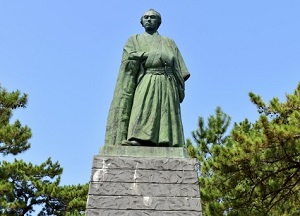
Statue of Sakamoto Ryoma (1836-1867), one of samurais who overthrew the Tokugawa government
In 1853, the warships with a negotiation team suddenly came from the United States.
They called for opening of Japan to the world.
The government was confused because of the unexpected visit and discussed both for and against.
Then, Japan opened the country next year.
After this, the government fell into confusion by succession issue of Shogun and careless conclusion of an adverse treat with the United States.
Here and there in Japan, many Bushis rose up to overthrow the government.
Some of them wanted to complete the modernizetion of Japan, because they had secretly acquired the information of advanced political and social system in Western countries.
The popular samurais are Sakamoto Ryoma (from Kochi in Shikoku Island), Saigo Takamori (from Kagoshima in Kyushu Island), Takasugi Shinsaku (from Hagi city), etc. (They always appear as the heroes in the drama set in this period.)
After some internal insurrections for several years, the Tokugawa government decleared the end of itself in 1867.
Japan marked the end of feudal period, and changed to the new modern country after advanced Western countries.
And many of above heroes joined the new government.
Meiji Period (1868 - 1912)
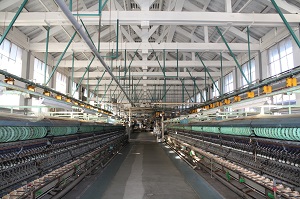
Tomioka Silk Mill built in 1872 (World Heritage Site), Photo by Tomioka City
A new modern nation started.
They changed the name of the capital from "Edo" to "Tokyo".
They instated Emperor Meiji as head of state, constituted the parliament, and established the Meiji Constitution.
They learned new social system, science, technology, culture from Europe and the United States.
To strengthen up the national power, they promoted industry and created the national army.
The rank of Samurai was abandoned, and all citizens became equal rank.
The sword of Samurai was taken away, and "chonmage" (a topknot, the hair style of samurai) was cut.
In Edo period, family name had been allowed for the rank over samurai.
But all people was forced to have a family name.
Japan modernized rapidly on its own power.
Following that, they hoped to do business in Korea.
But Korea was closing the country, and disliked the westernized Japan.
Japan forced Korea to open the country.
But China was considering Korea as a tributary.
After some skirmishes with 3 countries in Korea, Japan made war against China in 1894.
In 1895, Japan won the war and got a part of China and Taiwan.
A short time later, in northeastern China, Japan had a conflict with Russia, and got into a war in 1904.
Japan won this war miraculously, and got many rights in Korea and northeastern China.
And, at last, Japan realized annexation of the Korean Peninsula in 1910.
In 1912, the Emperor Meiji died, and his son became the next Emperor.
Taisho Period (1912 - 1926)
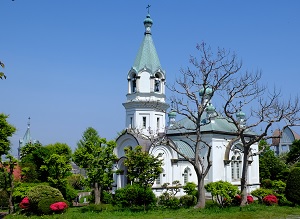
The Orthodox Church in Hakodate city built in 1917
In this short period, two big incidents occured overseas.
They were World War I (1914) and Russian Revolution (1917).
The former lead Japan to booming economy.
On the other hand, the latter drove the inflation and depressed economy.
Japanese government sent troops to Siberia to overthrow the revolutionary regime as a member of the Allies.
But, the nation made a heavy expense of war, but nothing gained.
Additionally in 1923, the Great Kanto Earthquake struck and the capital suffered catastrophic damage.
Then, the state of the national economy got worse.
During this period, the movement for democratization was active.
This was the foundation of the liberal democracy in Japan today.
After the great earthquake, many modern buildings were built in Tokyo, so the city landscape changed new.
Emperor Taisho was sickly, so he died in 1926. And his son became the next Emperor.
Showa Period - Until the end of World War II (1926 - 1945)
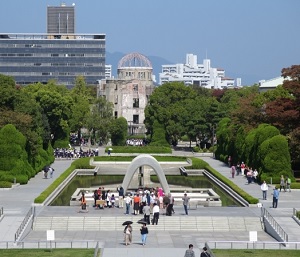
Hiroshima Peace Memorial Park
In 1929, the Great Depression occured.
A lot of countries in the world damaged in economy.
In Japan, many companies went bankrupt and created large-scale unemployment.
Therefore, Japanese politics lost the people's trust.
However, the military had a bigger voice in politics.
They said, "Manchuria (northeastern China) is the lifeline of Japan."
Although the government had decleared not to begin wars, the military caused a bombing incident of railway in Manchuria on its own, in 1931.
Then, the military claimed that China caused this, and invaded into China.
Next year the military occupied Manchuria, and established a new state "Manchukuo" (puppet state of Japan).
About this act, the League of Nations recommended to pull out the troops from Manchuria, but Japan refused this.
Then, Japan withdrew from the League of Nations in 1933.
After this, the military assumed the reins of government.
In 1936, Japan provoked the War against China.
The United States took up a strong position against this action.
Japan negotiated with the United State with patience, but did not win understanding.
Japan, at last, attacked at Pearl Harbor in Hawaii in 1941, and started the war between Japan and the United States.
At first Japan always won.
Japan invaded not only China but also some countries in Southeast Asia.
The area was the colonies of Britain, France and Netherland, and Japan drove them out from the area.
It is said that the action brought the independence of many Asian counties after the war.
But the rout of "Battle of Midway" in June 1942 was the turning point.
Japan had tough battles at all battlefronts, but the power of the United States was stronger than Japan.
On the other hand, the military always reported to Japanese people that all battles won, in order to lift the spirit for the war.
In 1944, the United States occupied the Saipan Island about 2500 km south of Japan.
Then many bombers attacked the mainland of Japan from Saipan.
A lot of main cities in Japan were destroyed in air raids.
Finally, the first A-bombing in human history executed in August 1945.
At Hiroshima on 6th, and at Nagasaki on 9th.
On 15th August, Japan made an unconditional surrender, and Emperor Showa told to all Japanese people by radio that Japan had lost.
Over three million Japanese people died in this war.
Showa Period - After World War II (1945 - 1988)
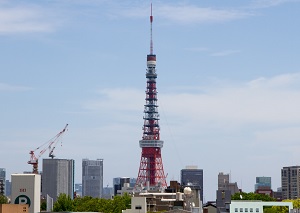
Tokyo Tower built in 1958
Japan was occupied by Allies, but the government of Japan could govern under control of Allies.
And, all occupied territories such as China, Korea, etc. were abondoned.
In 1946, new Constitution of Japan was established.
This constitution says, "We renounce war forever", "The Emperor is the symbol of Japan".
The draft of the Constitution was suggested by the Allies, and Japanese government accepted.
Emperor Showa decleared that he was a human being.
All Japanese people were surprised, because he had been a "living god" before that.
But after this, all Japanese people felt more familiar to the emperor.
Although the country was destroyed, all Japanese began to work diligently again.
In 1950 the Korean War started. This lead to booming economy.
In 1952 Japan joined the United Nations again.
In the 1960s, Japan built a high-growth economy.
In 1964, the world's first high-speed railway "Shinkansen" opened, and Tokyo Olympic Games was held for the first time in Asia.
In 1970, the World Expositon was held in Osaka.
But, High-growth economy lead to environment pollution and destruction of nature.
In the 1970s, energy crisis lead to period of low growth.
But in the 1980s, the industrial structure in Japan changed from material industry to high-value added industry.
On the one hand information technology developed.
"Bubble economy" was growing up.
In 1988, during the golden day of the bubble, Emperor Showa closed his long eventful life.
Heisei Period (1988 - 2019), Reiwa Period (2019 - now)
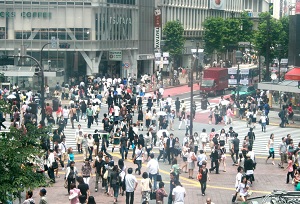
Scramble crossing in Shibuya in Tokyo
As soon as the period changed from Showa to Heisei, the bubble burst.
People began to review the real value.
But the bubble had made vast debt.
In 1990s, the work of Japanese is like to clear the debt.
In 1995, Hanshin Great Earthquake occured around Kobe city.
Japanese people were forgetting such great disaster, so were faced with nature's great force.
After that, diversification of individual values accelerated among Japanese people.
And we moved into the 21st century.
But in 2001, invisible terrorists attacked the western civilization.
After this, obviously there were a lot of changes in the world.
Weak Japanese economy increased cheap workers among young people.
In the result, Japan has faced declining birthrate and aging population.
Various national policy wasn't so effective, and national debt has increased rapidly.
Then, Great East Japan Earthquake occured on 2011.
Huge tsumani destroyed people's livelihood unmercifully, and it destroyed even nuclear power plant.
Japanese people decided to question ourselves.
About energy, about family, and about to live...
After the great earthquake, the frequency of strong eartquake in Japan was evidently increasing.
Now, Japanese people are living worrying about next coming disaster.
And one more thing, the countries around Japan are dangerous now.
China is thinking of expanding his territory.
North Korea is developing nuclear weapons without regard for warning from the international community.
Even South Korea is continuing to demand the apology about the colonial occupation by Japan in the early 20th century persistently, despite past repeated apologies.
But, network society is developing and new systems are created every day.
We are living in Japan with interesting to the future and facing threat.
In 2018, the Emperor showed his intention to abdicate the throne due to old age.
On April 30. 2019, he abdicated in the gratitude from all Japanese people, and new Emperor Naruhito ascended the throne receiving a heartfelt welcome on May 1.
Japanese people is in "Reiwa" era now.
But COVID-19 has spread from China to the world in 2020.
Even Japan is under threat of the virus.

